Appropriation has long been a staple of the postmodern scene and can be regarded as a kind of guerrilla resistance to oppressive social and economic conditions that characterize mass society. Such strategies have gained great currency at Burning Man. Black Rock City bristles with a wide array of mass produced effluvia. Kitsch symbols of popular culture are frequently displayed for their satiric and surreal effect. Indeed, the featureless playa of the Black Rock Desert represents the perfect foil for appropriation. It is an arena in which any object may be abstracted from its conditioning context in the conventional world and reinvested with new meanings. In the broadest view, this often represents a reappropriation of the expropriated. Potential elements of culture, appropriated as commodities within a mass market system, are reappropriated by the artist. The experience of passive consumption is reversed, replaced by personal initiative and creative investment. Many times this work eschews polemic and narrative context, as exampled by HELCO, and relies, instead, upon a simple and more lyrical transposition of media.
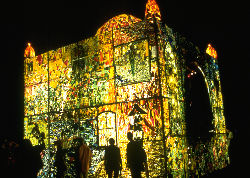
The Chapel of the Burning Book, installed at the event in 1998 by Finley Fryer, featured architectural construction — a large generic mosque-like structure — comprised of modular plastic panels. These translucent sheets formed elaborate “stained glass” mosaics assembled from found objects. Toys, ladles, hair curlers — a full range of recycled detritus sorted by shape, color and size — were thus transformed into a devotional object. Another example of this genre is The Haunted Junk, created by Steve Heck in 1998. Composed from burned pianos — “re-recycled”, as it were, from his work in 1996 — television sets and other technologic refuse, this sculpture formed a full-scale reproduction of a sailing ship. It was displayed in a remote location. Surrounded on three sides by illimitable space, it was transposed against an adjacent railroad track. The twice-daily transit of a train through this landscape imparted the illusion that this ghost ship moved upon the fossil surface of the desert lake bed.
A second attribute of art at this event relates to the world of nature and myth. The art of Burning Man, like work which has evolved within traditional societies, is tied to primal unities of time and place. The struggle to survive amid vast and inhuman natural forces has profoundly affected the character of this art. The 400 square mile playa of the Black Rock Desert is deemed to be the largest flat expanse of land in North America. It forms a featureless Euclidean plane devoid of any natural landmarks or life forms. This seemingly static tabula rasa, however, is an arena governed by immense and volatile powers. Ferocious dust blizzards scour its surface, creating global “white-outs.” Summer temperatures, regularly exceeding 100 degrees, create mirage effects, elongating and liquefying objects in the shimmering heat. Towering thunderheads, poised like frigates sailing overhead, generate fearsome lightning storms. Nature, palpable and imminent, is never far from the minds or, indeed, the skins of citizens of Black Rock City. Confronted by these awesome energies within a cosmically scaled theater of space, artists have incorporated aspects of this natural world into their art. This has included much large-scale environmental art in the tradition of Robert Smithson’s Spiral Jetty (1970), but quite unlike this classic site-specific work, these projects are often characterized by an assertive social and public purpose, as in the already cited example of Temporal Decomposition. Another work that demonstrates this tendency is a 25 foot tall pointed arch, entitled The Bone Tower. It was created in 1997 as a public landmark and entranceway to announce the presence of the Black Rock Rangers, Burning Man’s volunteer security organization. Designed by Michael Christian, this rebar-framed sculpture was composed entirely of cattle bones retrieved from the surrounding landscape. Other art that has engaged natural forces includes Larnie Fox’s Windmill, produced in 1997, and a series of four monumental spheres constructed by Chris Campbell in 1998. Entitled Orbicular Affect, these objects were employed as architectural accents near the pyramid supporting Burning Man. Crafted entirely from wood, they were designed as a specific medium for fire. In burning, they transformed themselves in several distinct and dramatic phases while generating 40 foot jets of flame.
Lastly, many works exploit the opportunities afforded by unbounded space. In 1998, the city-wide traverse of The Nebulous Entity relied on the mobility afforded by the flat and unencumbered surface of the playa. Moreover, this open terrain has also encouraged the creation of many other works which either contemplate or use the properties of large-scale ambient space. A ready example is this year’s Wheel of Time. This interactive arena will combine the work of many individual artists. Forming an immense circle inscribed on the desert floor, it will measure one half mile in diameter. Within this field, participants will travel through a spatio-temporal network that indexes installations as they relate to chronological periods. A similarly organized piece, The Very Large Array, was created by Aaron Ferrucci in 1997 and ’98. This extensive grid of sound emitting devices was arranged over a one acre tract. It generated a sonic environment controlled and modulated by the movement of participants.
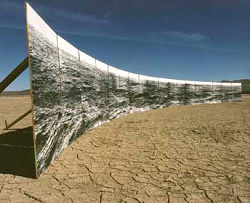
Mirrorage, by Shelley Hodes-Vaca, a 56-foot-long panoramic seascape composed from gelatin silver prints, was also installed in 1997. The faux perspective generated by this cyclorama evoked the enveloping quality of unlimited empty space, while referencing the playa as the remnant of a vast Pleistocene lake bed.
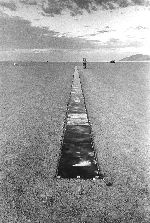
A similar telescoping of space, created from a sequence of aerial photographs, was displayed in 1998 by Michael Light. 133 16″ x 20′ color images obtained from NASA captured the stages of a lunar launch and descent. The center image in this series formed a 1:1 map, a perfectly matching model of the playa surface. Measuring 60 feet in length, Full Moon was flanked by blinking lights to simulate a landing strip.
This peculiar resonance of empty space in the Black Rock Desert warrants special attention. The sense of a surrounding void is paramount in this environment. Vacant perspectiveless space not only sunders objects from their context in the conventional world, it tends also to invest them with the quality of the numinous, a sense of the wholly other. Separated from a conditioning context, any object in such an environment assumes an identity that references only itself. In a world where there is nothing, any object of perception appears super-vitally real. It forms the sole evidence of its own existence.
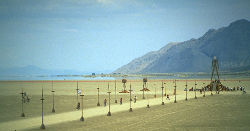
Certainly, the most obvious and prominent example is Burning Man. This sculpture achieved its present form in 1990. Its chief designer is Larry Harvey, although it is, and continues to be, a collaborative work. Elevated atop a stepped pyramid, Burning Man is approached along a monumental avenue that extends one half mile outward from a central civic plaza. For seven days and nights it forms an ultimate cynosure and a final point of reference for the citizens of Black Rock City.
Counterpoised against a vista formed by vast extents of earth and sky, it functions as an axis mundi, a world-generating locus of experience, such as is represented by temples or enshrined objects that form the focus of sacred art. Its construction, erection and ultimate sacrifice, long since codified as ritual tradition, is, by any functional standard, a sacramental and mythic act.
This same utilization of sacred affect is also evident in the work of Pepe Ozan. Over a five year period, Ozan has created ritual enactments within performance spaces which are formed in the semblance of temples. Called lingams, these structures are constructed from frameworks of rebar and metal mesh that are covered by a thin integument of fractally cracked mud. Filled with combustibles, they are set afire during an opera that employs hundreds of costumed performers. This year’s presentation will create a liminal space devoted to initiation. At its climax, thousands of participants will be led through a 15-foot-high ceremonial gateway near the base of the towers. The performance, entitled Le Mystere de Papa Loko, will occur at the position of 3 o’clock on the Wheel of Time. Another noteworthy installation, by Steven Raspa, appeared in 1998. Using artifacts appropriated from the gambling industry, Raspa fashioned an installation of 44 seven-foot artificial ficus trees arranged in North-South-East-West corridors. It contained a “Wheel of Faith” at its center. Referencing ideas of chance, faith, hope and prayer, this installation, entitled The Sacred Grove, is particularly interesting, in that it is carefully and consciously poised upon the boundary that divides the appropriative and profane from the iconic and sacred.
Regarded as mythic narration, the Wheel of Time, which is the centerpiece of this year’s artistic theme at Burning Man, also deserves further attention. Conceived and planned by Larry Harvey, these annual themes correlate the work of many artists. Harvey states:
The idea’s to produce an overarching theme that’s shared in common and a story that invites interpretation. We saturate people with a sense of this story beforehand. We use our newsletter and our on-site news-paper. Sometimes we stage interactive shows in San Francisco. A jointly held goal promotes collaboration. The themes we advance have a loose narrative structure, but the actual content is left up to individual artists. The theme forms a supportive spine, a sort of genetic core, to which many unique works and particular points of view can attach. Each effort then becomes a commentary of the whole. The result may be ambiguous, but I think that ambiguity is very useful. It invites participant involvement. People like to connect the dots. No two interpretations are the same. You could call this an act of collective story-telling.
The method here escribed bears a resemblance to the actual process of myth-making that occurs in unselfconscious and traditional societies. As students of myth and folklore are well aware, the polished literary creations which represent to us the classic canon of mythology derive from fertile oral traditions of story-telling. Such material evolves within social settings by a telling and re-telling which accretes complexity, and hundreds of variant strains may thus be generated. In their confluence, these narratives dynamically embody the entire range of experience within a cultural milieu. Myth-making is a social art form that depends on an informal and collective process —and the intensely interactive world produced at Burning Man may rightly be said to evoke this phenomenon.
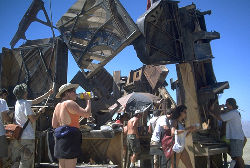
It may be argued that the art of Burning Man does not, for the most part, represent significant formal innovation. Certainly, very little can be said to be new amid the postmodern marketplace for style. The qualities that are refreshing in this work, however, derive from its communal and economic origins. This is not art that can be viewed independently of the process that fosters its creation. It is the fruit of self-expression elevated to a civic duty, a medium of gift exchange within a relentlessly social environment. This work is not designed to reify critical theory, nor has it been subsumed as a commodity within a marketplace. Burning Man is a revival of art’s culture-bearing and connective function. It is art that is designed to be touched, handled, played with, and moved through in a public arena. It solicits a collaborative response from its audience, even as it encourages collaboration between artists. It deliberately blurs the distinction between audience and art form, professional and amateur, spectator and participant. Burning Man is art that’s generated by a way of life, and it seeks, in its broadest aims, to reclaim the realms of politics, nature, history, ritual and myth for the practice of art. This is art with a utopian agenda.
The practice of art, like so many other disciplines in the postmodern era, has long been relegated to a professional ghetto in which institutional values predominate. Art works now exist as if to illustrate an increasingly arcane and specialized academic discourse. Furthermore, the currency of art within the greater public realm is controlled by a managerial elite of dealers and curators. Within a world governed by such externalities, careerism soon supplants vocation and professional image replaces vision. The life of the artist is now driven by what has been called an “organizational imperative”. To quote from author Suzi Gablik [Has Modernism Failed? 1984]:
In the case of the art world, the bureaucratic power structure is turned into a quasi-animate personality from whom everything is expected. Bureaucratic rules and procedures take the place of personal morality: this is what institutionalized morality means. The old values of individuality, indispensability, and spontaneity are replaced by new ones, based on obedience, dispensability, specialization, planning, and paternalism. The goal is security: to be part of the big powerful machine, to be protected by it, and to feel strong in the symbiotic connection with it. In the case of artists, these values are hostile to all that we know about the nature of creativity. And yet, to survive in this new order of things all must conform to the requirements of the modern organization — therein lies the problem.
What better remedy for this than Burning Man — a community that is created by artists themselves? Unless such ground can be secured in our contemporary world, some context for the production of art that is independent of the organized marketplace and freed from the dictates of a misapplied scholarship, it seems doubtful that any avant-garde challenge to the status quo can succeed. Indeed, if avant-garde movements originate upon the fringes of society, what better fringe could be secured than an experimental city located in the heart of a desert? If avant-garde movements extend themselves independently of established institutions, what better medium could be employed than the worldwide Internet? Finally, if avant-gardes challenge the rule of entrenched social interest and material gain, what better vehicle than a movement devoted to the essential calling of an artist’s life: the bestowal of spiritual gifts? Outsiders, it would appear, are coming in from the cold, and Burning Man is a phenomenon whose time has come.
Darryl Van Rhey is a writer on the subjects of art and religion who currently resides in Bolinas, California.

